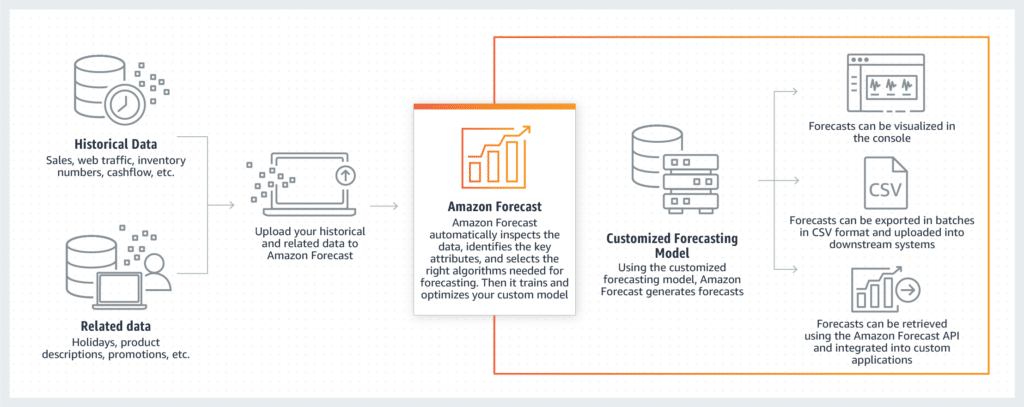Amazon Forecast stands as a testament to the power of machine learning, providing a fully managed service that leverages statistical and machine learning algorithms to produce highly accurate time-series forecasts. Designed to cater to a plethora of applications ranging from retail demand planning to supply chain management and operational planning, Amazon Forecast simplifies complex forecasting tasks without necessitating deep machine learning expertise.
Table of Contents
What is Amazon Forecast?
The Essence of Amazon Forecast
At its core, Amazon Forecast is a service that generates time-series forecasts by employing state-of-the-art algorithms. Drawing upon the same technology that fuels Amazon.com’s forecasting capabilities, this service is both powerful and accessible. It democratizes forecasting by enabling organizations of all sizes to harness machine learning for predictive insights, irrespective of their expertise in the field.
The Technology Behind Amazon Forecast
Utilizing machine learning and statistical algorithms, Amazon Forecast predicts future events based on historical data. It can manage datasets with multiple variables, offering predictions that are not only accurate but also relevant to specific business needs. This is achieved through the application of advanced algorithms, ranging from traditional statistical methods to more complex neural networks, ensuring that forecasts are reliable and actionable.
How Amazon Forecast Works
A User-Friendly Forecasting Process
Amazon Forecast simplifies the forecasting process, allowing users to easily import time series data, choose predictors, and generate forecasts. The service automates many of the steps typically associated with machine learning, such as data preprocessing, model training, and evaluation. Users can interact with Amazon Forecast through various means, including APIs, the AWS CLI, and the AWS Management Console, facilitating a seamless workflow from data input to forecast generation.
Streamlining Data Analysis and Forecasting
By automating the selection of algorithms and the handling of data anomalies, Amazon Forecast removes the complexities often associated with time-series forecasting. This automation ensures that the models generated are both accurate and tailored to the specific characteristics of the user’s data.

Key Features and Benefits of Amazon Forecast
Amazon Forecast heralds a new chapter in predictive analytics, offering features and benefits that address many of the challenges traditionally associated with time-series forecasting.
Automation and Ease of Use
A significant advantage of Amazon Forecast is its streamlined approach to forecasting. By automating the intricacies of machine learning, such as algorithm selection and data preprocessing, the service significantly reduces the barrier to entry for users. This democratization of forecasting means that users do not need a background in data science to generate accurate forecasts. The service automatically handles tasks like missing value treatment and holiday effect modeling, which are crucial for maintaining the integrity of forecasting models. Additionally, its integration with other AWS services allows for smooth data ingestion and output management, facilitating a more cohesive workflow.
Customization and Flexibility
Despite its high degree of automation, Amazon Forecast does not adopt a one-size-fits-all approach. It offers users the flexibility to customize models based on their specific needs. Through the service, users can specify the forecasting horizon, choose whether to include additional datasets for improved accuracy, and even manually select algorithms if they prefer. This level of customization ensures that forecasts are not only generated automatically but also tailored to the unique nuances of each user’s data.
Accuracy and Reliability
Amazon Forecast’s commitment to accuracy and reliability is evident in its use of advanced algorithms and machine learning techniques. The service taps into a rich repository of algorithms, from traditional statistical methods like Exponential Smoothing (ETS) to more sophisticated machine learning models such as DeepAR+. This diversity in algorithmic approach allows it to adapt to different data patterns and variabilities, ensuring that the forecasts it generates are both precise and dependable. The service’s algorithmic selection is further enhanced by Amazon’s extensive experience in forecasting, incorporating lessons learned from forecasting millions of time series at Amazon.com. This expertise is a critical component of the service, enabling it to provide high-quality forecasts that businesses can rely on for making strategic decisions.
Scalability and Performance
Another pivotal feature of Amazon Forecast is its scalability. The service can handle vast amounts of time-series data and generate forecasts for thousands of time-series simultaneously. This capability is particularly beneficial for businesses with extensive product lines or those operating in multiple geographic locations. Its scalability ensures that as a business grows, its forecasting capabilities can expand accordingly without a corresponding increase in complexity or resource allocation. Additionally, the service’s performance is optimized for speed, enabling users to generate forecasts quickly and respond to changing market dynamics in a timely manner.
Cost Efficiency
Cost efficiency is a cornerstone of Amazon Forecast’s design. The pay-as-you-go pricing model means that businesses only pay for the forecasts they generate and the compute resources they use. This approach eliminates the need for substantial upfront investments in infrastructure or software, making advanced forecasting accessible to businesses of all sizes. Additionally, the AWS Free Tier offers new users the opportunity to experiment with it, further reducing the barriers to entry and encouraging innovation.
Use Cases for Amazon Forecast
The scope of Amazon Forecast’s application is vast and transformative, stretching across multiple industries and functional areas.
Retail Demand Planning and Inventory Optimization
In the retail sector, accurate demand forecasting is critical for maintaining the right inventory levels—too much inventory ties up capital unnecessarily, while too little can result in lost sales and dissatisfied customers. Amazon Forecast enables retailers to predict product demand at a granular level, considering factors like seasonal trends, promotions, and economic indicators. This precision helps retailers optimize their inventory, reducing holding costs and minimizing stockouts. Moreover, it assists in planning for peak shopping seasons, ensuring that products are available when and where customers want them.
Manufacturing and Supply Chain Management
Manufacturers and logistics companies use Amazon Forecast to streamline their operations and enhance supply chain resilience. By accurately forecasting the demand for products and components, businesses can better plan their production schedules, manage their supply chain more efficiently, and reduce waste. This capability is particularly beneficial in industries with long lead times or complex global supply chains, where the cost of inaccuracies can be high. The forecast also plays a pivotal role in predictive maintenance within manufacturing, anticipating equipment failures before they occur and scheduling maintenance to prevent downtime.
Energy Consumption Forecasting
Utility companies leverage Amazon Forecast to predict energy demand, optimizing energy production and distribution to meet consumer needs while minimizing waste. This forecasting ability is crucial for integrating renewable energy sources into the grid, as it helps balance the variability of wind and solar energy production with consumption patterns. By accurately forecasting demand, energy companies can reduce reliance on costly and polluting peaker plants, contributing to a more sustainable energy future.
Financial Services for Risk Management and Planning
In financial services, Amazon Forecast aids in risk management and strategic planning by predicting cash flow trends, market demands, and potential financial exposures. Banks and financial institutions use it to forecast loan default rates, helping them manage risk more effectively. Insurance companies apply it to predict claims, enabling better capital allocation and pricing strategies. This predictive capability ensures that financial services firms can better withstand market volatilities and economic shifts.
Healthcare for Resource Allocation
Healthcare organizations apply Amazon Forecast to predict patient admissions and resource needs, including staff and equipment. Especially in times of heightened demand, such as flu seasons or pandemics, being able to forecast patient flow enables healthcare facilities to allocate resources more effectively, ensuring that they can provide high-quality care without overburdening staff or running out of essential supplies.
Customized Solutions Across Industries
Beyond these examples, Amazon Forecast’s flexibility allows for customized forecasting solutions tailored to the specific needs of businesses across industries. Whether it’s predicting web traffic for optimizing server capacity, forecasting workforce requirements, or estimating financial metrics, Forecast provides the tools necessary for data-driven decision-making.
Pricing Structure of Amazon Forecast
Amazon Forecast’s pricing structure is straightforward and transparent, with costs associated with three primary components: data storage, training, and forecast generation. This model allows businesses to plan their expenses based on their usage, avoiding any surprises in billing.
Data Storage Costs
The service charges for the storage of datasets used for training and generating forecasts. This means that the amount of data you store, measured in gigabytes (GB), directly impacts your costs. This aspect of the pricing model encourages efficient data management practices, prompting users to store only the data necessary for their forecasting needs.
Training Costs
Training costs pertain to the computational resources consumed during the model training process. Amazon Forecast utilizes your data to train custom forecasting models, a process that requires computational power. These costs are calculated based on the hours of training required, offering a direct correlation between the complexity and volume of your data and the associated expenses.
Forecast Generation Costs
Once models are trained, generating forecasts incurs additional costs. These are based on the number of forecasts requested, allowing businesses to scale their use of the service according to demand. This component of the pricing ensures that companies pay in proportion to the insights they extract from Forecast, aligning costs with value received.
Free Tier for New Users
Amazon Forecast offers a Free Tier for new AWS customers, allowing them to explore the service’s capabilities without incurring immediate costs. This offering includes a generous allowance for training hours, forecast generation, and data storage, enabling businesses to evaluate the service’s fit for their needs without financial commitment.






